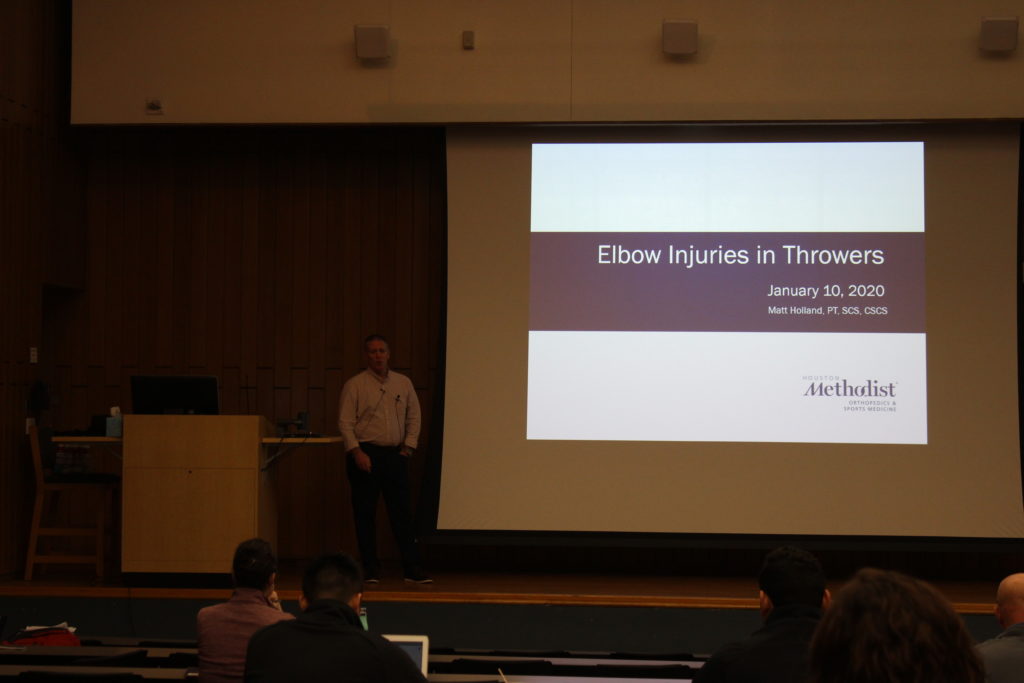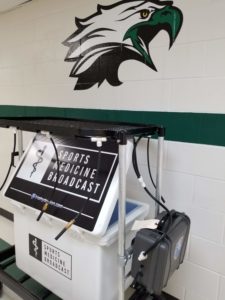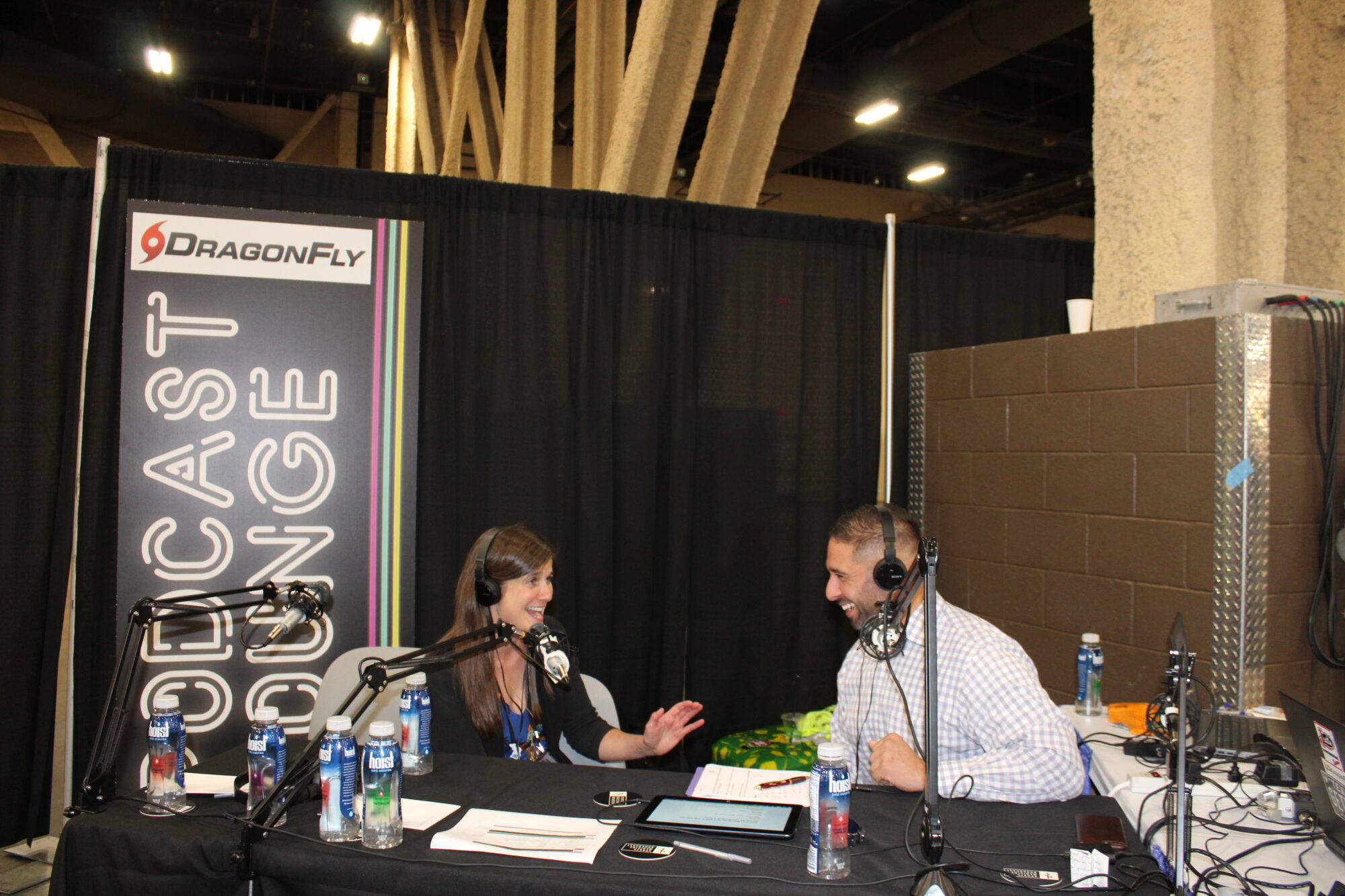Podcast: Play in new window | Download

Matt Holland joins us on the podcast today from Trinity University to talk about the Thrower’s Elbow.
Why do we see so many elbow injuries in throwers?
“A great deal of stress is placed on the elbow with throwing, particularly in the late cocking and acceleration phase. The forearm musculature has a limited ability to help with the stress load so the bone and ligaments of the elbow absorb a significant amount.”
Also contributing to the rise of injuries is the early commitment of young athletes to year-round baseball, especially in the south. As well as great rehab that doesn’t address mechanics or the importance of core and lower extremity strength as well as balance.
Are there factors that can be indicative that an athlete may suffer an elbow injury?
Rotator cuff weakness, altered scap position, altered throwing mechanics, GIRD and not using the core or lower extremity during throwing contribute to the elbow being injured. Dr. James Anderson states, “the #1 cause of elbow injuries is bad mechanics, and the #2 cause is overuse. Combine those two factors and you are doomed.”
UCL tears aren’t the only injuries we see in the elbow. What other ones might we come across?
Triceps tendonitis is common among throwers. Most often this is an overuse issue and athletes recover quickly with rest.
Flexor tendon tears can occur but are incredible frequent especially in younger throwers.
Valgus extension overload can cause repetitive abutment of the olecranon. It is important to look at mechanics here and ensure that there isn’t a UCL injury causing this.
Little League elbow is very similar to a UCL tear. However the weakest link in a skeletally immature body is the growth plate so this becomes injured instead of the UCL. The key to healing this is rest, rest and more rest coupled with parent education.
How important is rest with elbow injuries?
In a recent study published in 2019 the thickening of the UCL and the increased joint space of the elbow found in thrower’s experiencing elbow pain returned to normal on imaging after rest. However, if these athletes had GIRD that wasn’t addressed, that correlated with a continued increased joint space in the elbow.
What questions should we ask an athlete who comes to us with elbow pain?
What position do you play or combination of positions?
What is your volume of play?
Do you take time off?
Where is your motion does it hurt?
This question is of particular importance because if the pain is happening during the maximum external rotation found in late cocking it is usually a UCL issue.
What are the rehab guidelines post-TommyJohn surgery?
Protect the graft for 6 weeks and return normal strength to not only the elbow but to the shoulder, core and lower extremity. Focus on balance and at the 4-5 month mark throwing can begin. It is a long process because once throwing is started that is how we strengthen the ligament with little stressors. Throwing should include working on mechanics but stressing the ligament a little bit followed by rest. It’s also important to note the type of revision done because some revisions like the modified Jobe move the nerve and this becomes important to know while doing soft tissue work.
Does the UCL reconstruction have favorable Return-to-play?
Yes! 90% of post-surgical patients return to normal throwing biomechanics post-surgery.
What is important to remember regarding elbow injuries in the throwing athlete?
Great rehab is important but it doesn’t help if it is coupled with poor mechanics and it is critical that we have continued conversations with parents educating them on detrimental effects of year-round throwing in high volume without rest.
High loads with high-speed movements
Angular velocity of the shoulder is anywhere between 7 to 8 thousand degrees per second as the shoulder does from max external rotation to an internal rotated position. Then the elbow goes from a flexed to an extended position at 3 to 4 thousand degrees per second in which if there is a small break down in mechanics, strengths, and/or anatomical structure thats when things begin to go sideways.
Phases of throwing
Wind up: is when the athlete begins to move.
Early cocking (stride): In this phase the hands break and the arm moves into adduction, stride length increases the distance in which acceleration occurs so its basically storing the kinetic energy. Pelvic tilt and rotation also happen in this phase.
Supraspinatus, infraspinatus, and teres muscles act late in order to get your arm into an externally rotated position. The phase ends as the lead foot hits the ground. Due to the minimal involvement of the muscular structures, this is known as the power position of the shoulder.
Late cocking: In this phase this is when things begin to fire up.
From lead foot contact to max external rotation then when you add stride component and spine tilt that is when your arm is laid back from 165 to 180 degrees. Due to the angle of pull of the supraspinatus this provides glenohumeral compression at this time.
Max pelvic rotation and trunk rotation velocity. At the end of this phase, when your arm is laid back into max external rotation, the subscapularis, pec major, and latissimus dorsi all fire eccentrically in order to stop your arm from laying back completely and they also stop external rotation. The elbow has the most stress.
Due to the amount of stress at the elbow site, an elite fast ball is enough to tear the ligament if you were to repeatedly do that motion in a lab. “Everytime you throw a fastball its 35 newtons, at 33 newtons is what it takes to break a ligament in the lab”.
Acceleration phase: This is from the max external rotation position until the ball is released. The scapula has to retract and anteriorly tilt with serratus anterior creating the shoulder muscle forces that was slowing your arm down, are now shifting to concentric in order to create the acceleration to throw the ball.
Subscapularis activity is at its highest and this is also where you get the max 3 to 4 thousand degrees per second of the elbow going from a flexed to an extended position quickly.
Deceleration (ball release): This is considered to be the most violent phase for the shoulder, not so much to the elbow. There is an excessive distraction, posterior sheer, and high eccentric loads to the posterior cuff as well as an incredible amount of eccentric bicep activity in order to slow the elbow down to keep it from going into full extension.
Cocking, ball release and acceleration are the primary phases that you will see the most problems in.
Factors affecting injury
RC weakness
Altered scapular position
DIRD
Decreased use of LE/ Core
Decreased balance
Poor mechanics
Throwing Mechanics
Must address throwing mechanics in order to promote return to throwing after injury
Volume discussion in youth baseball
Dr. Andrews –
#1 is overuse
#2 is bad mechanics
If you have both you are … doomed
Pathomechanics – 11mins
Muscle contribution
Soft tissue
Flexor-pronator tendinitis – pain felt at ball release and not during the cocking phase of throwing.
Really common early in the season
Flexor tendon tears – not common
Nerve injury – more in adults
Numbness in 4th and 5th finger after throwing
Ulnar nerve subluxation
Bony Injuries – 15 min
Valgus extension overload
Radial capitellar joint
Little league elbow – 17 min
REST
Parental education is critical
Increased with year-round play
Growth plate is often weakest
Elbow ROM in pro pitchers
Elbow extension dec by 8 deg
Flexion dec by 6 deg
Total flexion ext arc dec by 15 deg
Flexion contractures up to 25deg deficit
Questions to ask
Position played
Volume
Baseball only
Year-round baseball
How much time off
How long have you been off throwing
Where in your motion does it hurt
UCL injuries – 22min
Rest from throwing 6-12 weeks
Normal cuff and scapular strength
Normal scapular control
Restoration of normal IR
Throwing Mechanics correction
Interval throwing program critical
UCL with internal bracing
Similar to ACL internal bracing
Much faster than a traditional UCL reconstruction
Balance and UCL tears – 26 min
In a study done by Craig Garrison from Fort Worth looked at 30 guys with UCL tears and without. The guys with tears showed a decrease in single leg with the Y balance test compared to the guys without the injury. So, if you have a kid who comes up and can't hold their balance and drops their elbow putting their elbow in a bad position those are the kids who get hurt.
During Rehab, by week 4 post-op you should be having these kids doing a lot of core, hip, and balance exercises then look at the shoulder.
UCL Surgery –
The elbow is made up of 2 bundles, the anterior and posterior bundle. The Anterior bundle is the main focus when talking about UCL surgery. It runs from the inferior aspect of the medial epicondyle and inserts into the sublime tubercle. The posterior bundle is pretty much the floor of the cubital tunnel. In the anterior bundle, you have an anterior and posterior band, the posterior band is the one that gets injured in baseball players. It primarily restrains valgus stress throughout its functional range of motion.
Importance of rest
Preseason GIRD vs post season – baseline returned to normal after 6 to 8 weeks of rest.
IT WENT BACK TO NORMAL WITH 6 WEEKS OFF
Shoulder tightness increases the risk of elbow injury
Only 42% of MLB pitchers with TJ returned to pitch 10 games or more.
Cost of TJ in MLB – $395 million average of 180 days
Biomechanical evaluation – 36 min
After shoulder surgery, you lose horizontal extension and external rotation which are two critical components in throwing.
RTP after shoulder surgery in baseball is at best 60%
Watch Matt Holland on Facebook Live
Contact us
Matt Holland
Sponsors help keep it going…help them keep us going
Frio Hydration – Superior Hydration products.
Donate and get some swag (like Patreon but for the school)
HOIST – No matter your reason for dehydration DRINK HOIST
MedBridge Education – Use “TheSMB” to save some, be entered in a drawing for a second year free, and support the podcast.
Marc Pro – Use “THESMB” to recover better.

